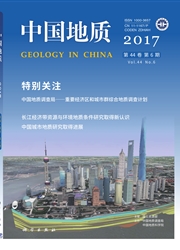

 中文摘要:
中文摘要:
作为喜马拉雅造山带变质核的高喜马拉雅杂岩带,是以高级变质岩石、普遍的深熔反应以及高温韧性变形为主要特征的热碰撞造山带。在高喜马拉雅平行造山的韧性伸展构造发现的基础上,建立高喜马拉雅挤出的3-D构造模式,并提出了挤出的动力学过程:(1)造成高喜马拉雅中弱和热物质产生的局部熔融阶段(46~35Ma),(2)平行造山的韧性伸展和重力裂陷阶段(28~26Ma开始),(3)韧性逆冲型剪切带形成阶段(〉626-23Ma),(4)MCT和STD的形成造成的高喜马拉雅挤出阶段(23~17Ma)。
 英文摘要:
英文摘要:
The Greater Himalayan Complex (GHC) , as the metamorphic core of the Himalayan orogen, shows a "hot" coUisional orogen characterized by high-grade (up to granulite facies) metamorphic rocks exhumed from the middle-lower crust, widespread migmatites from extensive anatectic processes and high-temperature ductile deformation. A three-dimensional tectonic model for extrusion of the GHC has been proposed based on the discovery of widespread orogen-parallel ductile extension. It is suggested that extrusion dynamic processes of the GHC are as follows: (1) partial melting in 45-36Ma resulting in the weak and hot middle crust, (2) orogenparallel gravitational collapse in 28-26Ma, (3) ductile thrusting since 〉 26 Ma and (4) ductile extrusion resulting from the formation of MCT and STD during 23-17Ma.
 同期刊论文项目
同期刊论文项目
 同项目期刊论文
同项目期刊论文
 Uplift of the West Kunlun Range, northern Tibetan Plateau, dominated by brittle thickening of the up
Uplift of the West Kunlun Range, northern Tibetan Plateau, dominated by brittle thickening of the up Geochemistry, zircon U/Pb geochronology and Lu\Hf isotopic composition of eclogites and their host g
Geochemistry, zircon U/Pb geochronology and Lu\Hf isotopic composition of eclogites and their host g Building of the Deep Gangdese Arc, South Tibet: Paleocene Plutonism and Granulite-Facies Metamorphis
Building of the Deep Gangdese Arc, South Tibet: Paleocene Plutonism and Granulite-Facies Metamorphis Eocene high grade metamorphism and crustal anatexis in the North Himalaya Gneiss Domes, Southern Tib
Eocene high grade metamorphism and crustal anatexis in the North Himalaya Gneiss Domes, Southern Tib Rock Damage Structure of the South Longmen-Shan Fault in the 2008 M8 Wenchuan Earthquake Viewed with
Rock Damage Structure of the South Longmen-Shan Fault in the 2008 M8 Wenchuan Earthquake Viewed with Petrogenesis of Miocene adakitic diorite-porphyrite in middle Gangdese batholith, southern Tibet: Co
Petrogenesis of Miocene adakitic diorite-porphyrite in middle Gangdese batholith, southern Tibet: Co Structural and physical property characterization in the Wenchuan earthquake Fault Scientific Drilli
Structural and physical property characterization in the Wenchuan earthquake Fault Scientific Drilli Reworking of the Gangdese magmatic arc, southeastern Tibet: post-collisional metamorphism and anatex
Reworking of the Gangdese magmatic arc, southeastern Tibet: post-collisional metamorphism and anatex The Mesozoic metamorphic–magmatic events in the Medog area, the Eastern Himalayan Syntaxis: constrai
The Mesozoic metamorphic–magmatic events in the Medog area, the Eastern Himalayan Syntaxis: constrai Diamonds, native elements and metal alloys from chromitites of the Ray-Izophiolite of the Polar Ural
Diamonds, native elements and metal alloys from chromitites of the Ray-Izophiolite of the Polar Ural Origin of podiform chromitite, a new model based on the Luobusa ophiolite, TibetOriginal Research Ar
Origin of podiform chromitite, a new model based on the Luobusa ophiolite, TibetOriginal Research Ar Precambrian evolution of the Lhasa terrane, Tibet: Constraint fromthe zircon U–Pb geochronology of t
Precambrian evolution of the Lhasa terrane, Tibet: Constraint fromthe zircon U–Pb geochronology of t Cambrian ultrapotassic rhyolites from the Lhasa terrane, south Tibet: Evidence for Andean-type magma
Cambrian ultrapotassic rhyolites from the Lhasa terrane, south Tibet: Evidence for Andean-type magma Building of the Deep Gangdese Arc, SouthTibet: Paleocene Plutonism and Granulite-Facies Metamorphism
Building of the Deep Gangdese Arc, SouthTibet: Paleocene Plutonism and Granulite-Facies Metamorphism Early-Neoproterozoic Grenvillian orogeny in Altun-Qilian -North Qaidam, North Tibet: new geochemical
Early-Neoproterozoic Grenvillian orogeny in Altun-Qilian -North Qaidam, North Tibet: new geochemical Orogen-parallel ductile extension and extrusion of the Greater Himalaya in the late Oligocene and Mi
Orogen-parallel ductile extension and extrusion of the Greater Himalaya in the late Oligocene and Mi Lithospheric Architecture of the Lhasa Terrane and Its Control on Ore Deposits in the Himalayan-Tibe
Lithospheric Architecture of the Lhasa Terrane and Its Control on Ore Deposits in the Himalayan-Tibe A genetic linkage between subduction- and collision-related porphyry Cu deposits in continental coll
A genetic linkage between subduction- and collision-related porphyry Cu deposits in continental coll Late Quaternary slip-rate along the central Bangong-Chaxikang segment of the Karakorum fault, wester
Late Quaternary slip-rate along the central Bangong-Chaxikang segment of the Karakorum fault, wester Long-term temperature records following the Mw 7.9 Wenchuan (China) earthquake are consistent with l
Long-term temperature records following the Mw 7.9 Wenchuan (China) earthquake are consistent with l Multiple generations of pseudotachylyte in the Wenchuan fault zone and their implications for coseis
Multiple generations of pseudotachylyte in the Wenchuan fault zone and their implications for coseis Iron isotope evidence for multistage melt–peridotite interactions in the lithospheric mantle of east
Iron isotope evidence for multistage melt–peridotite interactions in the lithospheric mantle of east Multiple metamorphic events revealed by zircons from the Diancang Shan-Ailao Shan metamorphic comple
Multiple metamorphic events revealed by zircons from the Diancang Shan-Ailao Shan metamorphic comple Kinematics of the Tengchong Terrane in SE Tibet from the late Eocene to early Miocene: Insights from
Kinematics of the Tengchong Terrane in SE Tibet from the late Eocene to early Miocene: Insights from Tectonic framework and crustal evolution of the Precambrian basement of the Tarim Block in NW China:
Tectonic framework and crustal evolution of the Precambrian basement of the Tarim Block in NW China: Formation of carbonatite-related giant rare-earth-element deposits by the recycling of marine sedime
Formation of carbonatite-related giant rare-earth-element deposits by the recycling of marine sedime 期刊信息
期刊信息
